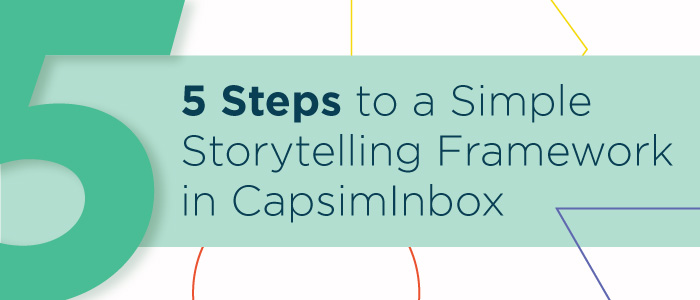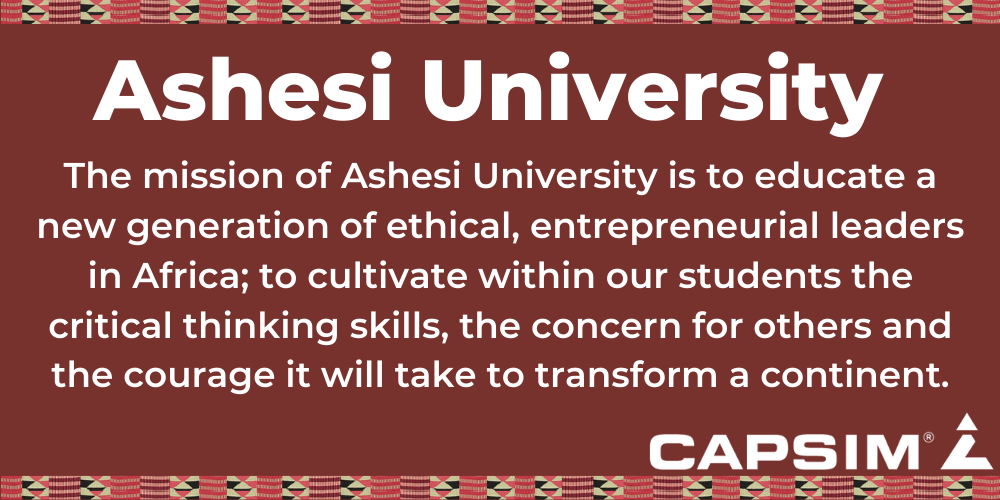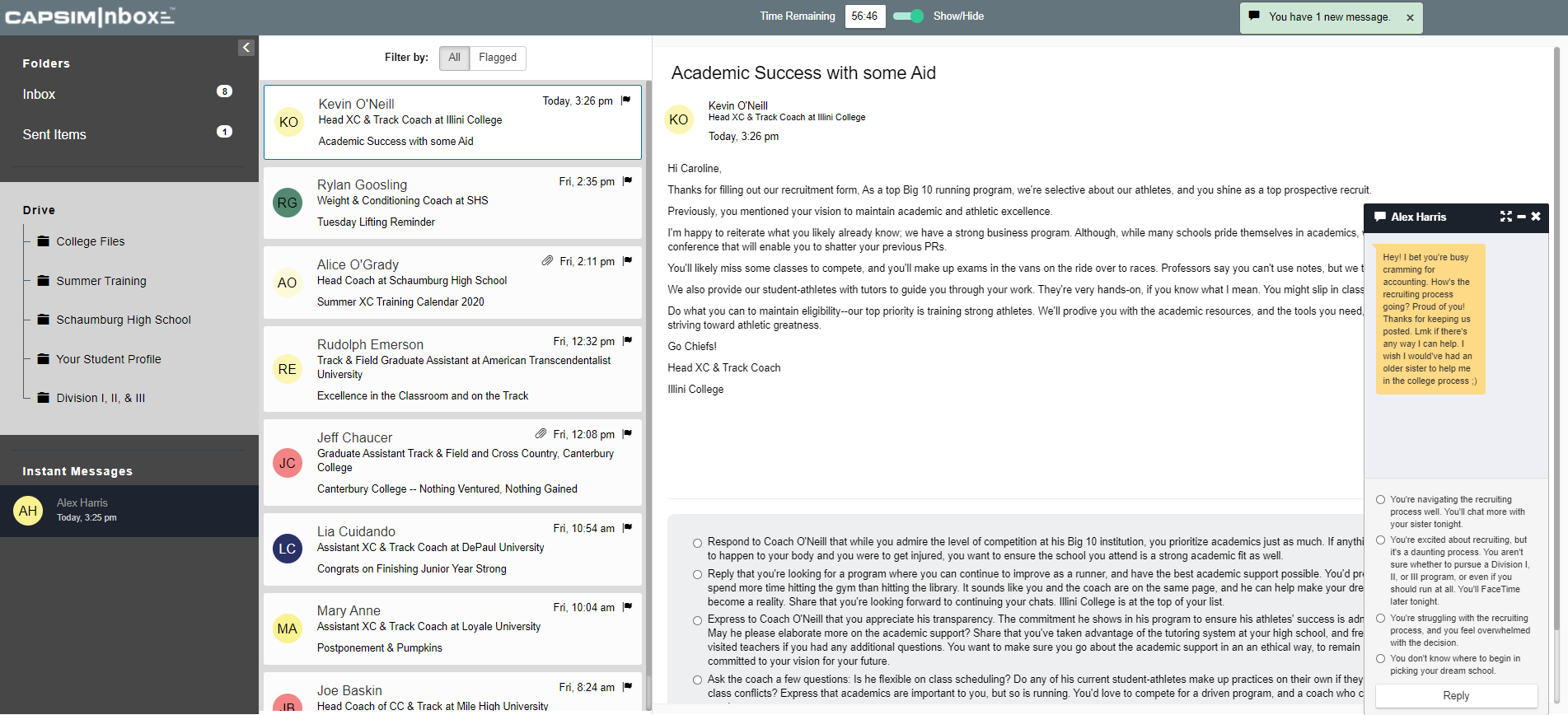5 Steps to a Simple Storytelling Framework in CapsimInbox
May 5, 2021

What if we told you that in just five simple steps, you could build the basis of an immersive, simulation-based learning experience?
We know the doubts that may be crossing your mind. “I’m not an author. I don’t even write. And I certainly don’t know how to code a simulation!”
Or perhaps most importantly, is it worth my time?
The CapsimInbox Authoring Platform provides a vehicle to bring the experience and expertise of subject matter experts to life—through an immersive email simulation.
You don’t have to be a world-class writer or programmer to create virtual simulations that immerse learners in real-world situations. If you can write an email (the average worker sends 40 a day), you can build an inbox simulation.
In this post, we’ll take you behind the scenes to reveal our step-by-step building process with CapsimInbox Authoring Platform so you can replicate it. Maybe—you’ll refine it better than we have.
The 5-step simulation-building process.
It’s crucial to identify and extract stories. Storytelling captivates audiences, influences behavior, and transforms individuals. It’s a secret superpower that’s underutilized and misunderstood. Ancient Egyptian hieroglyphs from 5,000 years ago depicted noblemen, gods, and the afterlife. Compelling storytelling survives the test of time.
After chatting with a few of our authors and those familiar with the platform, we boiled down our builders’ processes individually, spooned similar items into the same bowls, and distilled it down to five simple steps. It can be that easy.
1. Brainstorm a theme centered around a problem
How do you develop your idea? Think: problem first. Brainstorm a theme and try centering a simulation around a problem you’re passionate about. It’s easier to tell stories we’ve personally experienced.
As a former student-athlete in college, athletics is something that encapsulated my life for years. When the pandemic hit, I couldn’t help but realize a glaring problem. The high school recruiting process will undergo significant change in the pandemic. Higher education and college athletics weren’t prepared for a virtual world. So what would it look like? I decided to find out by leveraging my experiences as a student-athlete and interviewing experts in the field to learn how the industry has changed.
Now that you have your idea, you can morph it into something more concrete. Here are a few exercises that could be effective in bringing the story to life.
Pick a noun.
When it comes to moving from an idea to something of significant value, start small and pick a noun. Focusing on nouns is a fantastic trick to help bring stories to the forefront of our memories. When we think of nouns, they generally trigger memories or events that occurred—they can help surface stories to the forefront of our memories.
A baseball cap may bring back memories of a ball game in the summer’s sweltering heat with peanuts and cracker jacks and the seventh-inning stretch. From there, your mind may wander to sports, competition, and possibly even a doping scandal.
Ask yourself plenty of questions.
The right questions can unearth hidden caves of stories.
- What was one of the worst days on the job?
- Have you ever made a customer or student cry tears of joy?
- What was the worst day in the history of your corporation?
- What decision in your history could your organization not have survived without?
- When was the last time someone said you couldn’t achieve something? How did you prove them wrong?
Think about firsts.
Think about the first time you walked into a job interview. Maybe you remember your palms dripping in sweat or tripping in heels on the way to interview with the leader of the company (true story). Did you remember a firm handshake and to exude fake confidence even though you were anything but? What about the first terrible grade you received and what you learned from it? My mom duct-taped my first-ever C as a decoration above our dining room table for three months. A daily reminder of my failure during dinner time—and a successful push to do better on the next math test.
What emotions or lessons did you learn from a major sales pitch? Either with clients or convincing higher-ups at your institution or organization to bite in on an idea? Your heart might’ve skipped a few beats. Your breath might’ve hitched in your throat—eager in anticipation to spill what you’ve been holding internally for so long.
Determine the target audience.
Once you’ve found your story, it’s time to determine your intended demographic. Who’s the audience, and what’s the goal of your creation? Who will benefit from the story you’re telling? List the key stakeholders involved and how they can walk away with something valuable after your experience.
After the Ashesi University team agreed on the target audience being students at their university, conversations circulated the real-world challenges the team wanted their Ashesi students to face. Challenges like those found in mining—a dominant industry ridden with conflict.
“It was easy to decide what we thought a great simulation would be,” Fulbright Scholar Jennifer Seely said.
After building an Ethics in International Mining simulation, she and two other colleagues won Capsim’s GBSN Beyond Microsimulation competition. They started with their target audience: students. You can try the GBSN member-created microsimulations for free here to get a sense of the immersive storytelling that took home the ultimate victory.
It was important for the team to capture Ashesi University’s core mission: to educate a new generation of ethical, entrepreneurial leaders in Africa; to cultivate within its students the critical thinking skills, the concern for others, and the courage it will take to transform a continent.

Next, it’s time to identify and extract the best components of compelling stories.
2. Decide the goal of the Inbox and the skills you'll assess.
Perhaps you’ve never written a story before. Great news. Humans were born to be storytellers. The evolution of storytelling goes back to the prehistoric times of cavemen. They used signs, sounds, and drawings on rocks to tell their tales.
Even better news—we’ve since evolved in our storytelling techniques. And with CapsimInbox Authoring Platform, you don’t need programming skills to make it happen. Like cave dwellers, we ask for your imagination and your skilled hands to clack away at the keyboard.
But where do I start?
Well, you already have your target audience and the problem they’re facing. It’s time to propose solutions to address them. Consider what skills you’d like your participants to master by the end of this experience.
We’ve seen crises in business before—and in sports. Dr. Zack Damon looked for a tool to expose students to ethical decision-making, problem-solving, and communication. Skills needed in the sports industry but lacking in the classroom. The Sports Management Graduate Program Director and Assistant Professor at the University of Central Arkansas couldn’t find an existing solution in the market that exposes students to the immense pressure of dealing with a sports scandal. So he created one.
Dr. Damon realized it was possible to create a realistic and engaging experience for both students and practitioners to grow from. He was able to turn a crisis into a playable and engaging learning experience within the email simulation. By bridging the gap between theory and practice, he realized a unique opportunity to combine sports’ enticing nature with already-established business undertones.
CapsimInbox: Sports Management takes participants through a day-in-the-life as a General Manager of a Sports Team looking to make a championship run in the future. When a crisis centered around an alleged doping scandal arises, participants manage challenges and responsibilities that impact the success of sports franchises.
3. Research the Problem
I’ve been out of the college recruiting game for close to a decade now. It was safe to assume that even without a pandemic, much would have changed. I started conversations with subject matter experts and people in the field to make sure the content I created was relevant, meaningful, and representative of what student-athletes were going through. The more perspectives I could gather, the better.
It’s been eight years since Coach Beer showed up to 5 AM practices and ran alongside us on Schaumburg’s paved sidewalks. He sweated in solidarity with a bunch of giggling high school girls six days a week without complaint. I called him Coach Heineken once, and that was the only time he ever got mad at me.
As I drove along I-90, I called Coach Beer.
“Coach, I need your help,” I said. A million questions surfaced, racing through my mind at 80 mph, but I tried to consolidate them to a select few. How are you training the girls’ team? What does college recruiting look like now?
He was an official subject matter expert in college recruiting. And he had a lot to share.
But he wasn’t the only one I looped into the process. I reached out to Jeff Stiles, the head cross country and track coach at Washington University in St. Louis, a Division III school with top-tier academics and a competitive running program.
From a coach’s perspective, I can’t imagine what recruiting looks like right now. But I’d like to try. I’m creating an email simulation to help prospective student-athletes navigate recruiting during the pandemic.
Throughout these informational interviews and individual research, I tackled the looming question of what challenges are your students or organization struggling with?
After identifying and extracting the best stories from student-athletes, college coaches, and athletic academic administrators, I took the challenges student-athletes faced and created ways to solve them by building a CapsimInbox centered around the college recruitment process. I made the challenges come to life and redefined the existing recruiting process with Capsim’s authoring tool.
4. Create a compelling scenario.
Every great story has a hook. The scenario is the perfect place to capture the participant’s attention and create higher stakes in the experience. A “day in the life” would be dull if it were just a day in the life. So how do we make it exciting?
Think about your favorite TV show or book. What makes your fingers turn the next page in a novel? Or fail to stop Netflix from resuming to the next episode against your willpower?
Cliffhangers activate stress—when we’re faced with acute stress and not knowing what will happen next, our bodies release excess stress hormones. They also initiate fight or flight responses and build suspense to propel the story forward with a sense of urgency. Creating higher stakes introduces unexpected elements in your story that keep your audience engaged.
The star baseball player that’s a role model to his teammates, coaching staff, and kids who play tee-ball? It turns out he’s tangled up in a mess and might be involved in foul play. The mob of workers protesting outside your factory? They’re advocating for better work conditions, equal pay, and union representation–but you’re the bad guy that needs to sort it out. Connecting with your audience on an emotional level compels people to take action in ways they wouldn’t with a rational mindset.
One way to strengthen your story is to interweave elements to make it more cohesive. That email from your boss requesting an early morning meeting on a Monday? Add the back story. Make your protagonist more colorful with human fallacies, and distinguish what’s standing in the way of your participants’ success. Discover the sentiment of your story and spell it out for your audiences.
Dr. David McCalman, assistant Professor of Management at University of Central Arkansas, shared his building process. He sketched out the general ideas and storyline by first looking for a manageable number of skills he was looking to assess. Then, he delved into real-world examples and case studies to build out his scenario.
“I actually thought in terms of TV shows, which have story arcs within them,” Dr. McCalman said with a chuckle. “So you might have a story arc having to do with the acquisition of some other company, and that might last several items along.”
He sat down with a broad idea of the skills and then started outlining the stories. From there, it evolved into a sculpting process–trying to find precisely the best question to ask and how best to ask it.
In terms of context, before participants go through the simulation, it’s important to provide detail of the company or industry background. Empower your participant with their role in the simulation. Show them how long they’ve been in their position as a Director of Sales and Operations, VP of HR, or Brand Manager. Answer any looming expectations before your participants enter into the experience.
5. Build out your characters.
Compelling characters in stories, movies, and in our lives have different approaches, responses, biases, and personas. Remember to breathe life into your characters and garner inspiration from the incredible (or maybe not so great) people you’ve encountered in your life.
Who’s the main protagonist, and what is their role in your firm or institution? What factors influence your character’s decision-making process?
Most stories have at least one villain–whether it’s a Marvel movie or Sherlock Holmes. The protagonist will face a series of trials and challenges to outsmart them. Define the protagonist–the driver of your story–and what they’re up against.
A scenario may look something like, You’ve worked your way up the ranks from a customer service representative to the president of your company. Recent shifts in the economy have forced your company to make significant cuts to keep your organization afloat. You find yourself facing impossible decisions.
Remember Dr. McCalman we mentioned earlier? He’s Capsim’s first author to continue the narrative and characters from one CapsimInbox world and bring them into another. His next Inbox will extend the fictitious universe he built in CapsimInbox: Managerial Accounting into another business focus.
The same bosses and CFOs that hounded students with high expectations in managerial accounting will be coming back for more–in the realm of finance. Students who took his previous courses will connect their engaging learning experiences with his fictional world.
Next Steps
In our next post, we’ll talk about the logistics of creating compelling emails, IMs, and including supporting documents and external links to make your Inbox come to life.
But until then, we created a demo Inbox to help you put your skills to the test. The prompt will guide you through the building process. Try it out to see what you create in your brainstorm session.
Start Building in CapsimInbox today.
Put these five steps into practice and start building with CapsimInbox Authoring Platform today. Help your students close soft skills and develop stronger leaders in the workplace with our free building tool.



.png?width=80&name=1-questions%20(1).png)